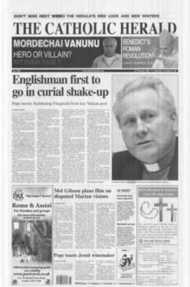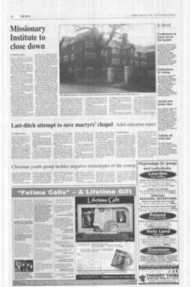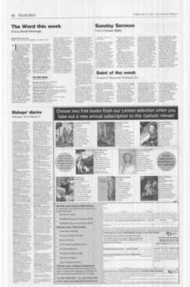Page 13, 24th February 2006
Page 13

Report an error
Noticed an error on this page?If you've noticed an error in this article please click here to report it.
Tags
Share
Related articles
A Convert Poet : Siegfried Sassoon
Siegfried Sassoon's `haunting Music'
Aesthete And Man Of War
A Poet Of Discovery?
'the Old Lie: Dulce Et Decorum Est Pro Patria Mori'
John Jolliffe on the troubled life of Siegfried Sassoon — poet, novelist, soldier and Catholic convert
The Passionate Pilgrim: Siegfried Sassoon by Max Egremont, Picador, £25
Together with Wilfrid Owen, who was a fellow patient and friend, Siegfried Sassoon was the First World War poet par excellence. This was partly thanks to his brilliant imagination, but also due to his remarkable feats of physical and moral courage. The latter inspired him famously to throw his hard-won MC into the Mersey, having composed a rousing anti-war statement, "as an act of wilful defiance of military authority... not protesting against the military conduct of the war but against the political errors and insincerities for which the fighting men are being sacrificed". He could well have been court martialled, but the Army wisely decided against this and its doctors consigned him to Craiglockart, an asylum-like hospital near Edinburgh, which he nicknamed Dottyville.
He had nightmares about the poet's insoluble dilemma: trying to write protest poetry and be a hero in a situation of despair, where heroism, like patriotism, was not enough. Later, he returned to the Army in France, where he was wounded again, this time by friendly fire.
His troubles as a poet were only beginning. Before the war he had spent his time gently playing cricket, hunting, and writing mild pastoral verse, seldom published, except at his own expense. His wartime poems, mainly on the horrors suffered by ordinary soldiers, had immense impact, but when the war was over, what next?
He found it almost impossible to discover a voice and style suited to the vacuum years of the 1920s. He had no time for the Modernist movement of Joyce, Pound and Eliot. He despised obscurity, and did not feel inspired to protest against the twin disasters of Communism and Fascism in the 1930s. His tone seemed old-fashioned and stilted, a throwback to Hardy and the world of Edmund Gosse. But he did learn from Robert Graves to be natural and idiomatic, though relations between them see-sawed.
His personal life became a sad mixture of homosexual lust and consequent guilt. The reader is spared no details of Sassoon's passion for the insufferably narcissistic, affected and spoilt Stephen Tennant, or of their absurdly selfish rows and reconciliations.
A tour of America, with poetry readings and lectures, comes as a relief, especially when an old lady in Philadelphia told him: "I feel as if I had been at the funeral of the world." Then it was back to a life spent mostly in vapid company, endlessly trailing round England and Europe, with a series of mostly unworthy spongers whom he treated with unfailing and undeserved generosity. This central section of the book could surely have been pruned to great advantage.
But in 1927, temporarily forsaking poetry, he published the first volume of his fictionalised autobiography, Memoirs of a Fox-hunting Man, to enormous acclaim. In spite of Mr Blair's Government, it is still in print today, and has been set, together with the war poems, as a text for both 0and A-levels. Two more volumes followed in 1930 and 1936, the second of which, Sherston's Progress, has an epigraph from Bunyan: "I told him I was a Pilgrim, going to the Eternal City."
His journey was briefly helped by his marriage in 1933 to Hester Gatty (who had herself gone through a mental breakdown) and by the birth of an adored son, George. But tensions soon arose, and the marriage did not last, giving way to mutual misery and accusations of instability.
Sassoon's days became emptier and more isolated, Edmund Blunden and the actor Glen Byam Shaw, being, for a time, the only friends that he felt like seeing. Mercifully, however, he again began to visit Katharine Asquith, whose husband and brother had been killed in the war, and Mgr Ronald Knox, who spent his last years at her home at Melts, situated between Sassoon's large, empty house near Warminster and Downside Abbey, where several of the monks became his close mentors and friends.
Thanks to them, and to two nuns, Mother Margaret Mary McFarlin and Dame Felicitas Corrigan, by 1957 he was ready to join the Church. The latter's book, Siegfried Sassoon: Poet's Pilgrimage, contains a short but fascinating insight into his spiritual development as well as placing him in his context more generally. If Max Egremont is not illuminating on the religious aspect, his understanding, fairness and, above all, his industry everywhere else have been remarkable. Especially in the first part of the book, he speaks with an original and attractive voice of his own. To give one example from many, he skilfully attributes the famous anti-war manifesto to a mixture of "emotion, compassion, vanity, guilt and trauma of his wounds". (Another influence at the time was that fallible, autocratic know-all Bertrand Russell.) Egremont has had access to many notebooks and to other unpublished material not available to previous biographers, which accounts for some prolixity, and some loose ends.
But this biography eclipses the earlier ones, and it is hard to see how another on the same scale will ever be needed.
blog comments powered by Disqus

















